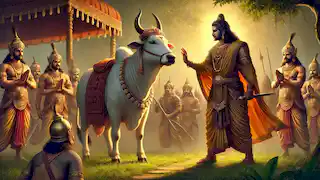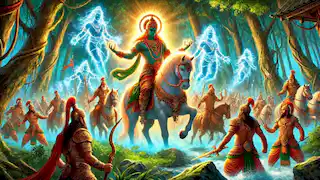The Legend of the Divine Cow Kamadhenu
Reading Time: 8 min

About Story: The Legend of the Divine Cow Kamadhenu is a Legend from india set in the Ancient. This Descriptive tale explores themes of Wisdom and is suitable for All Ages. It offers Moral insights. The story of Kamadhenu, the divine cow that grants wishes and teaches the path to true prosperity.
In the rich tapestry of Hindu mythology, few creatures hold the mystical allure and revered status as Kamadhenu, the divine cow. Known as the "Cow of Plenty," Kamadhenu is believed to possess miraculous powers to grant any wish. She embodies the essence of prosperity, nourishment, and fertility. The legend of Kamadhenu has been passed down for generations, shaping the moral and spiritual values of Indian society, while illustrating the deep connection between humanity and the divine. Long ago, during the era of the gods and the ancient sages, the universe was a vibrant mix of energies—celestial beings, demons, and mortal souls coexisted in the vast cosmic order. Kamadhenu’s origins trace back to this primordial time, emerging from the sacred ocean during the churning of the Milk Ocean (Samudra Manthan), an event described in many ancient Indian texts. During this epic event, the gods (Devas) and demons (Asuras) united to churn the great ocean to extract the nectar of immortality, Amrita. The process was perilous and filled with moments of tension as both sides, though rivals, temporarily aligned to achieve their goal. Out of the ocean arose several divine gifts—the Moon (Chandra), Lakshmi (the goddess of wealth), the deadly poison Halahala, and, among many treasures, Kamadhenu, the wish-fulfilling cow. Kamadhenu, with her lustrous, ethereal beauty, emerged as a symbol of bounty and eternal grace. The gods were astonished by her presence, recognizing her as an eternal source of life-sustaining nourishment. Her body shimmered with celestial light, her large, peaceful eyes radiating wisdom and compassion. Though she was offered to the gods, Kamadhenu soon became the possession of the great sage Vasishta, one of the Saptarishi, the seven ancient sages of wisdom. In the serene hermitage of Sage Vasishta, Kamadhenu was a central figure. Her presence brought unimaginable abundance. From her, Vasishta’s disciples and all the inhabitants of the hermitage were fed with the finest milk, butter, and ghee. Kamadhenu could produce any food or resource that was required, instantly and in infinite quantities. She represented the spiritual principle that through the purity of devotion and righteousness, all material needs are met effortlessly. Vasishta’s Ashram became a beacon of peace and learning, largely because of the divine cow. Scholars, sages, and travelers alike marveled at the abundant hospitality provided by the Ashram, unaware that the source of this bounty was Kamadhenu. The cow also had the power to manifest entire armies to protect the righteous and serve the sage's needs whenever he wished. Kamadhenu’s fame spread far and wide, reaching even the ears of kings and warriors, but not everyone viewed her with the same reverence as the humble sage. One day, the powerful King Vishwamitra, while wandering through the forests with his army, came upon Sage Vasishta’s Ashram. The king was astounded to see the simple yet extraordinarily prosperous life led by the inhabitants of the hermitage. Vasishta welcomed the king and his entire army with open arms, offering them all the food and comforts they needed. Vishwamitra, curious about the source of this wealth, asked Vasishta how he managed to provide such hospitality. Vasishta revealed Kamadhenu to the king, explaining her divine powers. King Vishwamitra, although a great warrior, was consumed with envy. He had conquered many lands and amassed great wealth, yet he could not match the resources provided by this humble sage’s cow. Sensing the immense value of Kamadhenu, Vishwamitra proposed that Vasishta gift her to him, offering him an unimaginable fortune in return. But Vasishta, wise and humble, refused. He knew Kamadhenu was not just a possession, but a divine entity that belonged in his Ashram, fulfilling a greater cosmic purpose. Vishwamitra, however, was not accustomed to refusal. The king, overcome by greed, attempted to take Kamadhenu by force. He ordered his soldiers to seize her and take her to his kingdom. But Kamadhenu, recognizing the injustice, resisted. She transformed herself into a fierce, celestial being, producing from her body an army of warriors who overwhelmed Vishwamitra’s forces. The king’s army was decimated, and Vishwamitra himself was humiliated. The defeat at the hands of a sage and a divine cow deeply wounded Vishwamitra’s pride. He realized that mere physical power and wealth were no match for the spiritual strength that Vasishta wielded. In his fury and shame, he renounced his kingdom and his life as a warrior, vowing to attain the same spiritual power as the sage. Thus began Vishwamitra’s long and arduous path to becoming one of the greatest sages in Indian history. Kamadhenu’s significance transcends the material abundance she provided. In Hindu mythology, she is regarded as a symbol of Dharma (righteousness). She embodied the principle that true wealth and prosperity come from living in harmony with divine principles, not from the hoarding of material possessions. Sage Vasishta often used Kamadhenu to teach this very lesson to his disciples and those who visited his Ashram. Through her, he demonstrated that selflessness, devotion, and purity of heart were the true paths to abundance. It was through living a life of virtue and aligning with cosmic principles that Kamadhenu’s blessings could be received. Over time, Kamadhenu became a symbol of motherhood, nurturing, and fertility. Her image is often invoked in rituals seeking prosperity and protection. Even today, many Hindu households pray to the cow, considering her sacred and an embodiment of Kamadhenu’s divine qualities. Kamadhenu’s legacy continued through her divine offspring, the Surabhi cows. The Surabhi, also known as Nandini, were believed to have inherited Kamadhenu’s miraculous powers, though each with unique attributes. Nandini, one of the most famous of Kamadhenu’s daughters, became equally revered in Indian mythology. Nandini resided in the hermitage of Sage Vasishta, much like her mother. Her presence was instrumental in many mythological stories, including one involving the famous Pandavas of the Mahabharata. During their time in exile, the Pandavas came across Nandini, who provided them with sustenance during their time of hardship. Her blessings helped them survive and regain their strength to eventually reclaim their kingdom. The Surabhi cows were considered divine beings, and their milk was said to possess mystical properties that nurtured both the body and soul. Thus, Kamadhenu’s legacy of nourishment, abundance, and protection lived on through her descendants, perpetuating the cosmic balance and ensuring the survival of righteousness. Even in contemporary times, the reverence for cows in India can be traced back to the legend of Kamadhenu. The cow is still seen as sacred, and many families maintain the practice of caring for cows, believing them to be manifestations of the divine mother. In villages across India, cows are often treated as part of the family, and their milk continues to be seen as a source of health and vitality. The symbolism of Kamadhenu also finds a place in India’s agricultural and spiritual practices. Festivals like Gopashtami, dedicated to the worship of cows, pay homage to Kamadhenu’s divine nature. During these celebrations, cows are bathed, adorned with garlands, and worshipped with great devotion. It is believed that by honoring the cow, one invites prosperity and harmony into the household. Kamadhenu’s story is not just a myth; it is a living legend that has shaped the values and traditions of Indian society. She continues to be a symbol of the Earth’s nurturing spirit, a reminder of the interconnectedness of all life, and the boundless generosity of the divine. Kamadhenu’s legend endures as a powerful reminder of the divine principles that govern life. Her presence in Vasishta’s Ashram, her miraculous powers, and her embodiment of Dharma continue to inspire reverence and devotion. The divine cow is more than just a provider of material wealth—she is a symbol of spiritual abundance, a testament to the fact that the universe provides for those who live in harmony with its laws. Her story also serves as a reminder of the dangers of greed and pride, as seen in Vishwamitra’s failed attempt to possess her. The king’s transformation from a warrior driven by material wealth to a sage seeking spiritual enlightenment is a testament to the power of Kamadhenu’s divine influence. Kamadhenu remains an enduring symbol in Hinduism, embodying the ideal that true wealth comes not from material riches but from living a life of righteousness, humility, and devotion. As long as her legend continues to be told, the values she represents will inspire generations to come.The Birth of Kamadhenu
The Role of Kamadhenu in Sage Vasishta’s Ashram

King Vishwamitra and His Desire

Kamadhenu’s Connection to Dharma
The Descendants of Kamadhenu

Kamadhenu in Modern India

The Eternal Symbol of Abundance

















